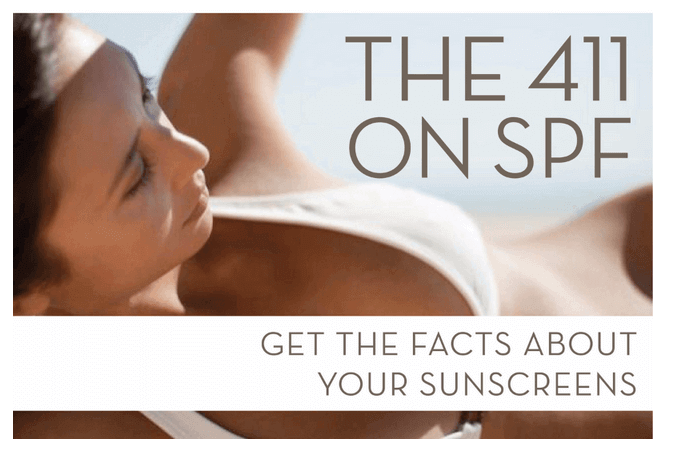May is Skin Cancer Awareness Month. We’re encouraging you to take sun protection seriously this month and give it all the attention it deserves. Throughout the month we will be publishing new articles about skin cancer, sun protection and how to treat your sun damage.
Summer is here and that means trips to the beach, pool, tennis courts, riding bikes and just spending more time outdoors in general. We’ve heard enough in the media about the risks of sun exposure and skin cancer, so most of us will be stocking up on sunscreens. But with so many brands available it’s hard to know which sunscreen is best. It used to be simple: just pick one with a high SPF and you’re seemingly protected.
Unfortunately, simply relying on SPF was not really protecting our skin. Recently, the FDA has issued new rules and guidelines on sunscreens. While these will ultimately lead to better protection, it has made choosing a sunscreen a lot harder. It’s not as simple as it used to be, but if we educate ourselves about the ingredients, we can make a smart choice, instead of just choosing blindly based on price, brand loyalty and pretty packaging. The good news – it’s pretty simple, once you know what to look for you can find good options. We’ve broken down the most important things to know below.
Why SPF is not the most important thing
As we said above, most people look at the SPF number when they purchase a sunscreen. They think that the higher the SPF the more protected they are. This is not true. To explain let’s start with some basic information about the damaging sun rays that sunscreens are supposed to protect us against.
There are two main types of ultraviolet rays that affect our skin. The first, UV-B, are the rays that cause sunburns and tanning. While UV-B rays do cause sunburn, which means your skin was over-exposed, they make a smaller contribution to long-term skin damage or cancers than you think. It’s the UV-A rays that silently penetrate further into the skin and damage your DNA (that’s bad.) Since UV-A rays penetrate deeper skin layers, they don’t cause sunburn, but they do cause photo aging and increase the risk for skin cancer. THIS IS IMPORTANT: the rays that you need to be most concerned about protection against are the UV-A rays. These are the rays that are present all day every day of the year. They are present in all kinds of weather, they pass through glass (office and vehicles) and they are 50 times more prevalent than UV-B rays. Now back to SPF.
The SPF number that you see on sunscreen labels rates how effectively a sunscreen blocks UV-B. Simply put, SPF ratings are the amount of time you can be exposed to sun without burning, they have nothing to do with protecting you from harmful UV-A rays. You can buy a sunscreen with an SPF of 80 and receive no protection against the more harmful UV-A rays.
So if you aren’t supposed to look at SPF numbers, what are you supposed to look for?
When choosing a sunscreen, you should base your decision on several things starting with the list of ingredients. Of the 15 ingredients that are currently approved in the United States for use as sunscreens, only 4 block UV-A. The other 11 provide little or no UV-A protection. So, when you buy a sunscreen it is important to choose one that contains at least one of the approved ingredients for UV-A protection.
The 4 ingredients that block UV-A rays are avobenzone, ecamsule, titanium dioxide and zinc oxide. The last two, titanium dioxide and zinc oxide are called physical blockers because they block absorption by reflecting the ultraviolet light. In the past, these physical blockers were not widely used because they left an opaque or white cast on the skin, but manufacturers have been able to micronize the particles resulting in a much nicer look and feel that is still as effective as the old ones that lifeguards used to wear.
At Nashville Cosmetic Surgery, we recommend that you choose a sunscreen that contains zinc oxide or titanium dioxide if at all possible because they provide the best broad spectrum coverage. Meaning they protect against both UV-A and UV-B rays. In fact, we only carry sunscreens that contain the recommended level of zinc oxide since zinc oxide reflects the broadest range of UV rays and it rarely causes skin irritation. If you see ingredients other than avobenzone (Parsol 1789), ecamsule, titanium dioxide or zinc oxide, they are only keeping you from getting sunburned. They have little effect on preventing premature aging or cancer.
Then why do manufacturers use those other 11 ingredients that don’t block UV-A?
Because it is much cheaper to produce a clear sunscreen that feels and smells good using those other 11 ingredients. But if you consider the expense involved with treating age spots, wrinkles and skin cancer from photodamage, it is cheaper in the long run to invest in a better quality sunscreen that protects you against this damage than to deal with the damage once it has occurred.
Watch for next week’s topic on what else you should look for on a sunscreen label and we will recap with a sunscreen shopping cheat sheet.

